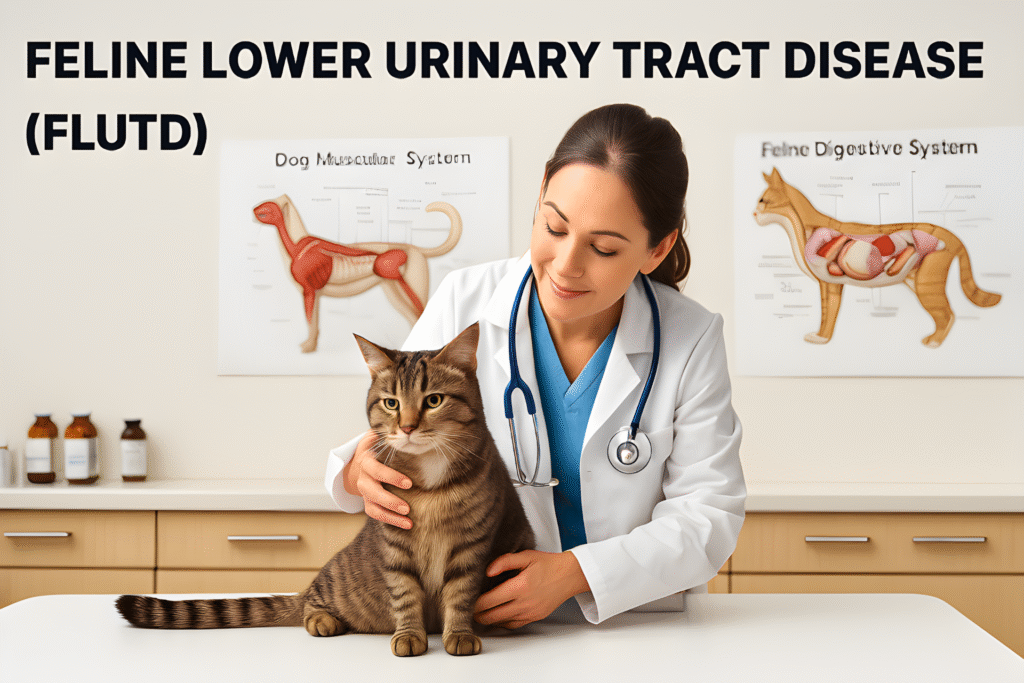Diagnosis and Care for Feline Lower Urinary Tract Disease
What makes feline lower urinary tract disease (FLUTD) dramatic is how quickly it turns serious.
That’s the reality of feline lower urinary tract disease. Even a single obstruction can cause pain, systemic imbalance, and life-threatening situations.
This condition usually starts as subtle warning signs that progress over time. Hence, effective and timely veterinary care is important to deal with the issue before it worsens.
In this article, we will explore how to tackle feline lower tract urinary disease (FLUTD) with precision, compassion, and practical strategies that actually work.

Feline Lower Urinary Tract Disease
Understanding FLUTD and Its Clinical Relevance
FLUTD is not one single condition. It’s a collection of disorders of the feline lower urinary tract. From urethral obstruction to idiopathic cystitis, the range is quite broad and unpredictable.
In many cats, feline lower tract urinary disease occurs as a recurring disorder. Pet owners can easily observe FLUTD cat symptoms such as straining, vocalization, and even blood in urine. These signs impact quality of life and pose real risks of kidney damage and overall health issues.
That’s why FLUTD is more than just another UTI. It’s a clear warning sign that needs careful diagnosis and treatment. And that’s exactly what we’ll discuss next.
Diagnostics: Beyond First Impressions
On first glance, FLUTD signs can be deceiving. Straining may appear like constipation in cats. A cat hiding under the bed can look stressed or frightened. The first mistake is making assumptions without testing.
Urinalysis remains the primary diagnostic tool. It shows cat urinary tract crystals, pH changes, and other signs of infection. However, imaging is also needed at times for proper diagnosis. Radiographs and ultrasounds can detect stones or anatomical differences that urine alone can’t predict.
Skipping this step often delays treatment. In FLUTD, time is crucial for the patient. Once the diagnosis is clear, the focus shifts to management, where diet plays a key role.
Care And Management Protocols
Cat lower urinary tract disease is rarely solved with just one pill or intervention. Long-term success requires a mix of nutrition, lifestyle, and medical management.
- Prescription diet: Prescription diets are crucial. Specialized urinary diets can reduce crystal formation, dilute urine, and lower the risk of recurrence.
- Hydration Strategies: Hydration in cats matters a lot, too. Using wet food or cat water fountains can significantly improve daily care.
However, diet is only one aspect. Stress management, good litter box hygiene, and medical treatment when needed work together in a complete care plan. Without this layered approach, relapse to the disease is very likely in your cats.
Management involves more than just prevention. It also includes preparing for challenges and providing long-term care.
Preventing Recurrence
The most frustrating thing about feline lower urinary tract disease is that it often comes back. It is usually a recurring disorder. Even after successful treatment, cats can frequently show symptoms of the disease again.
Simple preventive strategies, such as increasing water intake and encouraging regular activity, can lower the risk of relapse. Pet owners need clear and practical advice to deal with this condition in their pets. Veterinarians should reinforce these preventive strategies at each visit.
However, even the best preventive measures can fail at times. That’s the time when more advanced treatments are needed.
When Surgery Becomes Necessary
For the majority of cats, medical and dietary management is effective. But in cases of severe and recurring obstruction, surgical treatment becomes the last solution.
Although it is intrusive, it can be a lifesaver and can help prevent recurring blockages. The decision might not be easy to take, but it’s worth it in certain medical situations.
From surgery to supplements, each option in FLUTD care reminds us of one fact: Knowledge is our best tool.
Why Continuing Education Matters in FLUTD
Veterinary medicine is constantly changing. Over the course of time, new research is introducing new diets and treatment plans. Not keeping up means lagging behind in your veterinary care experience.
Because of this, staying connected through CE, like a feline lower urinary tract disease webinar, is more than just professional growth. It’s a way to have the most up-to-date and effective tools and techniques at your disposal.
Final Thoughts
Feline lower tract urinary disease ( FLUTD) requires both vigilance and treatment. Diagnostics prevent us from making wrong assumptions. Moreover, nutrition supports recovery, and communication fosters compliance.
However, long-term success depends on consistency. Regular check-ups and early intervention can prevent small issues from developing into emergencies. Each case of FLUTD reminds us that while medicine offers tools, the ongoing partnership between the veterinarian and the pet owner ensures lasting results.
Ultimately, FLUTD care isn’t just about treating a bladder; it’s about protecting the life and well-being of the cat.
FAQs
How long can cats live with FLUTD?
With proper care, cats can even live their full lives with FLUTD. Early diagnosis, careful diet, and regular monitoring can reduce the chance of recurrence. This ensures that cats live a healthy and long life.
When is euthanasia indicated for FLUTD?
Euthanasia is considered only in severe and untreatable cases. If a cat experiences frequent blockages and ongoing pain that can not be treated, it may become an option. Most cat cases, however, can be managed effectively.
How much does the treatment of FLUTD in cats cost?
Costs for the treatment of lower urinary tract diseases in cats can vary. Initial tests, like urinalysis and imaging, may be moderate, while emergency obstruction treatment can be more expensive.
